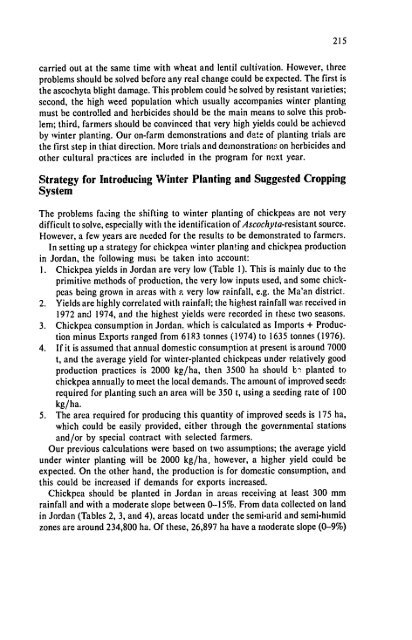I - --ii
I - --ii
I - --ii
Create successful ePaper yourself
Turn your PDF publications into a flip-book with our unique Google optimized e-Paper software.
carried out at the same time with wheat and lentil cultivation. However, three<br />
problems should be solved before any real change could be expected. The first is<br />
the ascochyta blight damage. This problem could be solved by resistant vat ieties;<br />
second, the high weed population which usually accompanies winter planting<br />
must be controlled and herbicides should be the main means to solve this problem;<br />
third, farmers should be convinced that very high yields could be achieved<br />
by winter planting. Our on-farm demonstrations and date of planting trials are<br />
the first step in thiat direction. More trials and demonstrations on herbicides and<br />
other cultural practices are included in the program for next year.<br />
Strategy for Introducing Winter Planting and Suggested Cropping<br />
System<br />
The problems facing the shifting to winter planting of chickpeas are not very<br />
difficult to solve, especially with the identification of Ascochyta-resistantsource.<br />
However, a few years are needed for the results to be demonstrated to farmers.<br />
In setting up a strategy for chickpea winter planting and chickpea production<br />
in Jordan, the following musi be taken into account:<br />
I. Chickpea yields in Jordan are very low (Table 1). This is mainly due to the<br />
primitive methods of production, the very low inputs used, and some chickpeas<br />
being grown in areas with F very low rainfall, e.g. the Ma'an district.<br />
2. Yields are highly correlated with rainfall; the highest rainfall was received in<br />
1972 and 1974, and the highest yields were recorded in these two seasons.<br />
3. Chickpea consumption in Jordan, which is calculated as Imports + Production<br />
minus Exports ranged from 6183 tonnes (1974) to 1635 tonnes (1976).<br />
4. If it is assumed that annual domestic consumption at present is around 7000<br />
t, and the average yield for winter-planted chickpeas under relatively good<br />
production practices is 2000 kg/ha, then 3500 ha should th . planted to<br />
chickpea annually to meet the local demands. The amount of improved seedr<br />
required for planting such an area will be 350 t, using a seeding rate of 100<br />
kg/ha.<br />
5. The area required for producing this quantity of improved seeds is 175 ha,<br />
which could be easily provided, either through the governmental stations<br />
and/or by special contract with selected farmers.<br />
Our previous calculations were based on two assumptions; the average yield<br />
under winter planting will be 2000 kg/ha, however, a higher yield could be<br />
expected. On the other hand, the production is for domestic consumption, and<br />
this could be increased if demands for exports increased.<br />
Chickpea should be planted in Jordan in areas receiving at least 300 mm<br />
rainfall and with a moderate slope between 0-15%. From data collected on land<br />
in Jordan (Tables 2, 3, and 4), areas locatd under the semi-arid and semi-humid<br />
zones are around 234,800 ha. Of these, 26,897 ha have a moderate slope (0-9%)<br />
215

















